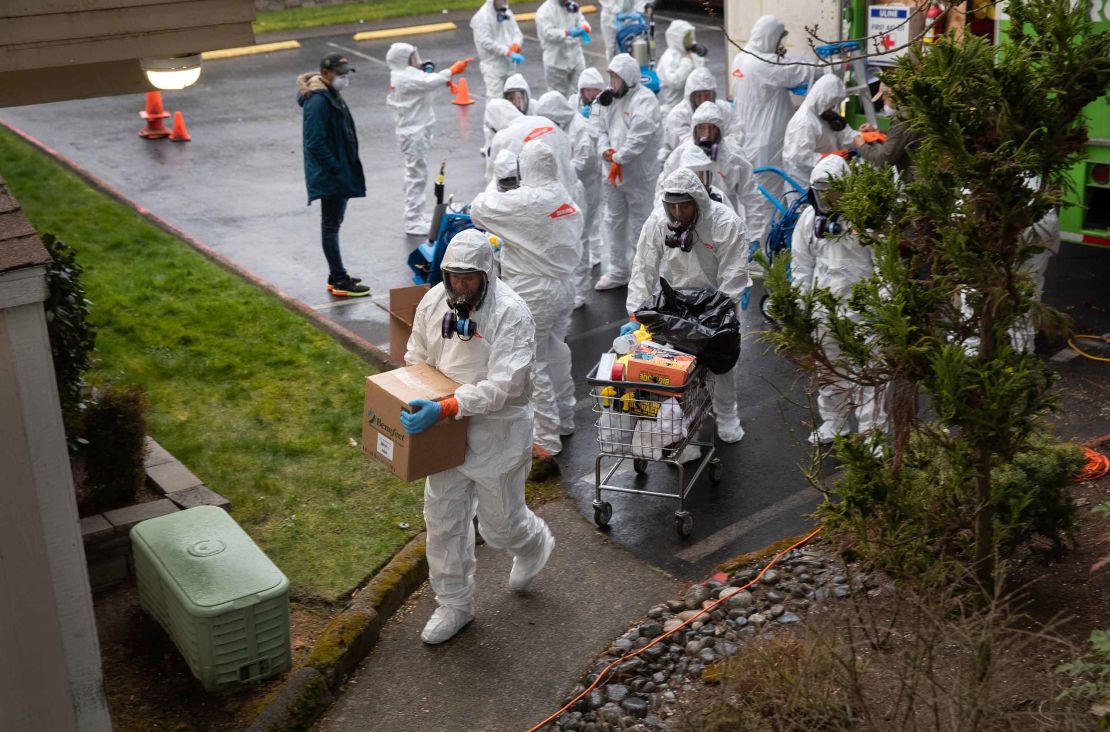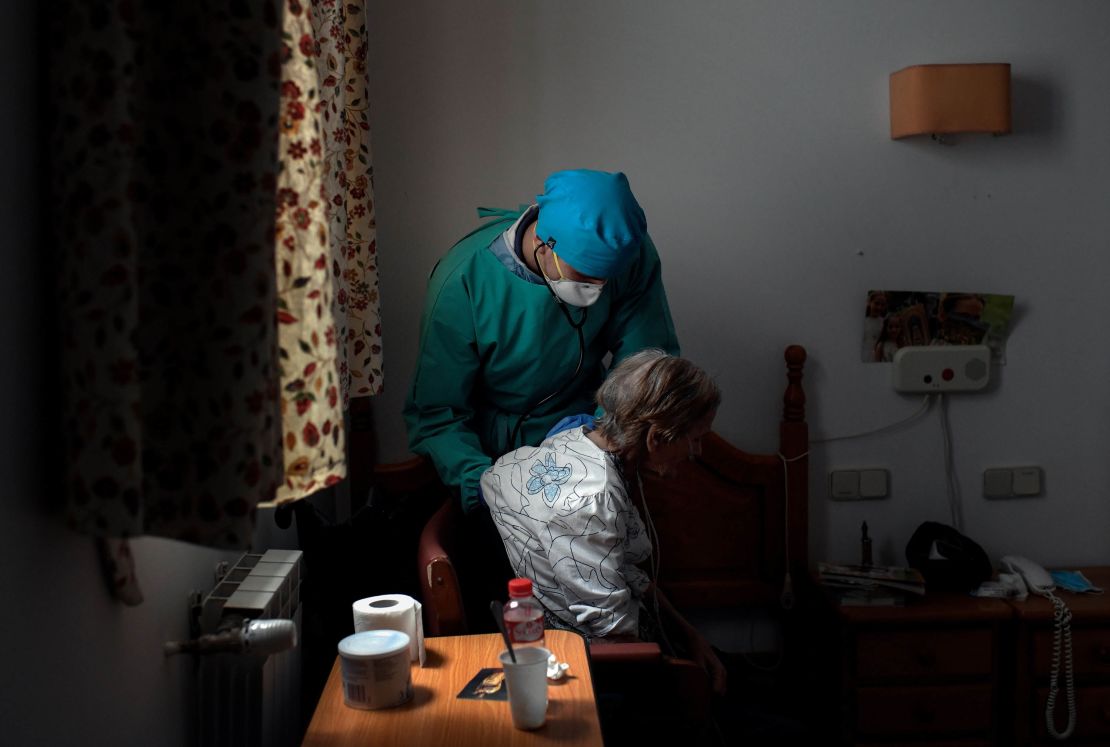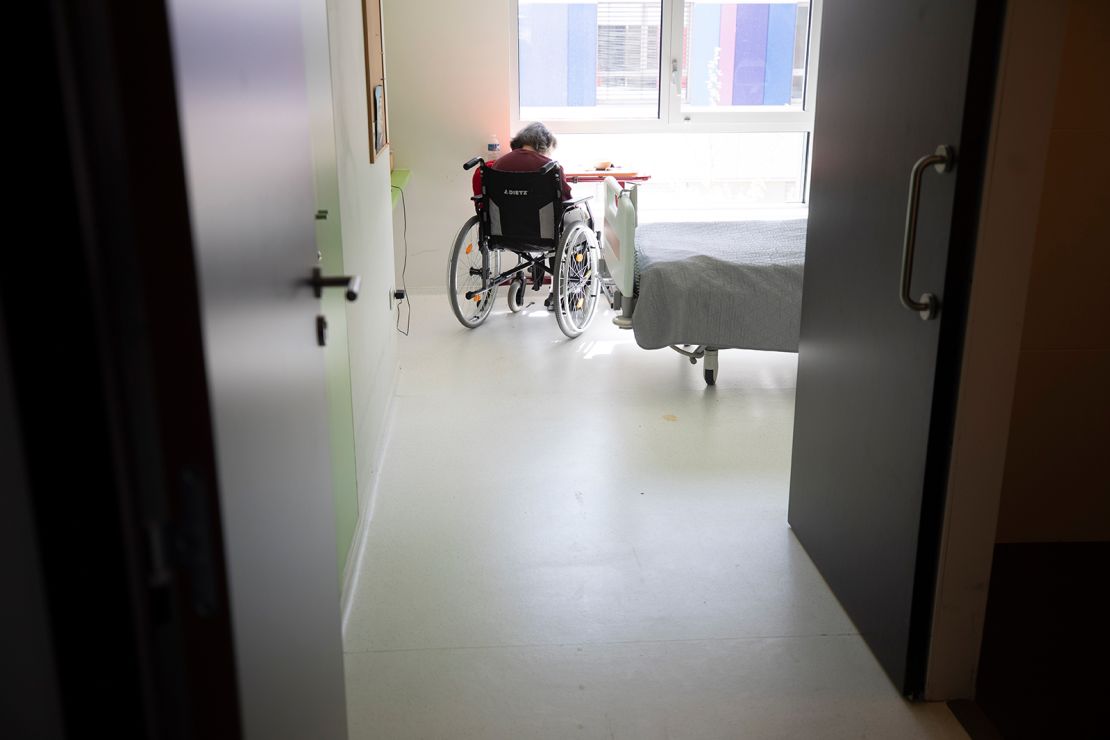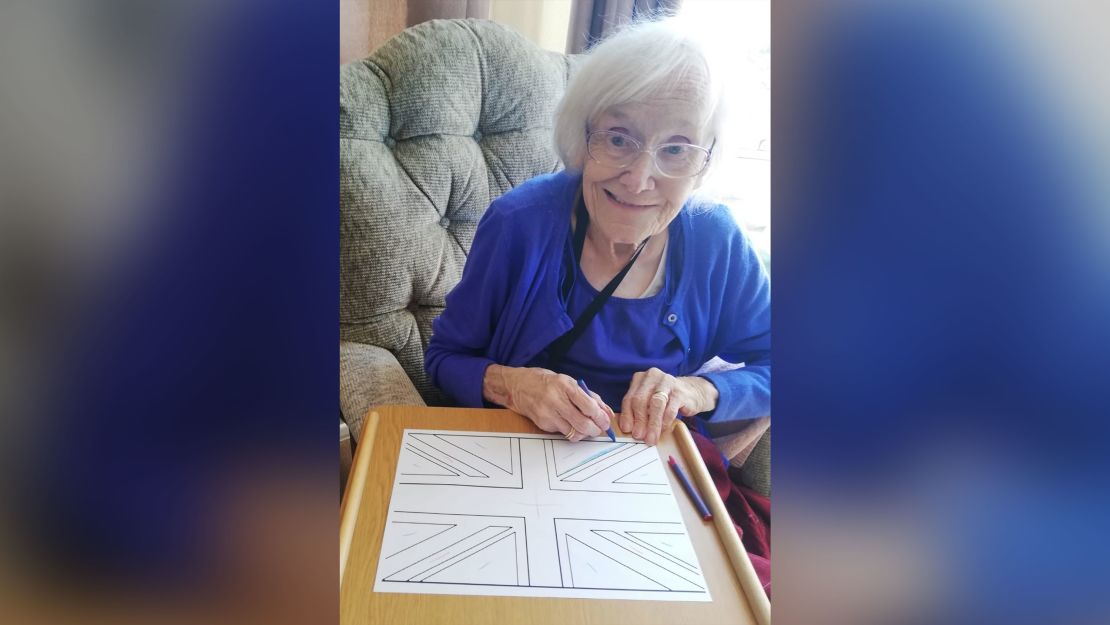Three months ago, as the novel coronavirus began to gain a foothold in countries across Europe, officials in the UK said they were still confident that the risk to the British public remained low.
By February 25, the World Health Organization said the virus had already killed thousands in China and was spreading through northern Italy, but at the time there were just 13 confirmed cases and no deaths in the UK. While the government ordered hospitals to prepare for an influx of patients, its advice to some of the country’s most vulnerable people – elderly residents of care or nursing homes – was that they were “very unlikely” to be infected.
That guidance would remain in place over the next two-and-a-half weeks, as the number of coronavirus cases in the UK exploded. By the time the advice was withdrawn on March 13 and replaced with new guidance, there were 594 confirmed cases, and it was too late.
By May 1, of the 33,365 total confirmed deaths in England and Wales, at least 12,526 – or 38% – were care home residents, according to the latest estimates from the Office of National Statistics (ONS).
While the UK government has defended its handling of the issue, care home staff and experts placed at least some of the blame for Europe’s highest death toll on the prioritization of hospitals over these facilities. Others have blamed the slow rollout of testing, the government’s alleged pursuit of “herd immunity” (which it denies seeking) and its failure to order a lockdown early enough.
The UK is not alone. Many other nations were slow to respond to the threat at care home facilities, and the consequences have been devastating.

Early struggles
Researchers based at the London School of Economics (LSE) created the Long-Term Care responses to Covid-19 (LTCcovid) group with its International Long Term Care Policy Network (LTCPN). LTCcovid is a global network of academics and experts in the field who gather and analyze official data from around the world, and found that many countries were seeing high rates of severe infections and deaths in care homes.
Comparing death tolls can be difficult: some countries have separate data covering elderly care homes, while others include facilities for those with disabilities. Some countries do not include in their data those residents who die in hospitals, some have regional variation, and some have no data at all.
Many governments are just starting to record death tolls in care homes – and the figures are staggering.
Data published on LTCcovid shows that more than half of all coronavirus deaths in nations including Belgium, France, Ireland, Canada and Norway occurred in care homes or among care home residents in all settings. In the US, data collated by the Kaiser Family Foundation (KFF) from 35 states and included in the LSE report showed that care home residents accounted for 30,130, or at least 34.6%, of the more than 87,000 coronavirus deaths recorded as of May 15. Care home residents are also overrepresented in some countries with relatively few deaths, accounting for 26 out of the first 99 deaths documented in Australia, or more than a quarter of all fatalities through May 18.
Sweden has repeatedly defended its controversial decision to remain relatively permissive in its restrictions on movement, but Health Minister Lena Hallengren admitted a “big failure” to protect the elderly and said care homes were now of the utmost importance, according to Swedish media. There had been 1,661 coronavirus deaths among care home residents out of 3,395 total coronavirus deaths in Sweden by May 14, or 49%, according to LTCcovid’s report.
“France, Spain, and Italy were overwhelmed by the virus very quickly,” said lead LSE researcher Adelina Comas-Herrera, from the university’s care policy and evaluation center. “They were the first countries in Europe to have these problems on a big scale. And I think they offered a lot of lessons that ideally could have been learned in other European countries.”
Despite having a large elderly population, Italy failed to take early action on care homes, according to LTCcovid’s research. Italian newspaper Il Post reported that residents at homes in the northern Lombardy region were getting sick or dying “much more than normal” in the weeks leading to March 30, and documented a lack of PPE (personal protective equipment) and testing in these facilities.
The management of care homes in Italy is handled at a regional level. The Italian National Institute of Health launched a survey to investigate but was still missing data on more than 4,000 homes as of April 14, according to the LTCcovid report.
Prime Minister Giuseppe Conte’s spokesperson told CNN that he hasn’t made a statement on care homes.
A similar story played out in France, where coronavirus fatalities among care home residents in all settings make up more than half of all coronavirus deaths recorded as of May 18, according to health ministry data used in the LTCcovid report.
Data in Spain is inconsistent, with some regions including facilities for people of all ages with disabilities. The number of confirmed coronavirus deaths in care homes as of May 10 was 9,642, 30.2% of 31,889 coronavirus deaths in total, according to health ministry data cited in the LSE report.

Italy, France and Spain
At the peak of the outbreak in northern Italy, on March 8, the Lombardy government asked nursing homes to make room for non-critical Covid-19 patients, to ease pressure on hospitals. The regional government said later that homes would receive 150 euros ($160) per patient taken.
Raffaele Antonelli Incalzi, head of the Italian geriatric society SIGG, said in a statement in early April that care homes were “biological time bombs,” in part because overcrowded hospitals were moving elderly patients to unprepared homes.
On April 1, a source at Lombardy’s health department – who requested anonymity because they had not sought authorization to speak to media – told CNN that the department had prioritized testing new admissions to hospitals and medical facilities over testing existing patients such as those at care homes.
The Lombardy government told CNN it is not giving interviews on “the nursing home issue,” due to an ongoing independent investigation into the region’s high number of care home deaths that it launched on April 7.
The first coronavirus reports in France came on January 24, but the first press release mentioning care homes came on March 6, and said guidance had only been distributed among them that day. The first death in France was reported in mid-February, but the country did not start specifying care home deaths in their reported numbers until April 2.
President Emmanuel Macron ordered a state requisition of masks in a tweet on March 3. These were given first to regional hospitals and pharmacies, which were in charge of supplying care homes and private health workers, according to a March 13 Health Ministry press release.
According to a Reuters investigation, the requisition disrupted the supply chain in the early days of the pandemic, causing some nursing homes to suffer a two-week delay receiving masks they had ordered.
Elderly care sector professionals and care home workers published a letter to Health Minister Olivier Véran on March 20 expressing alarm and requesting 500,000 masks per week in affected areas, to which he agreed.
Jean-Pierre Riso, president of the National Federation of associations of directors of establishments and services for the elderly (Fnadepa), told Reuters that the delay “contributed to the spread of the virus in nursing homes,” but there is no evidence of a direct link between the requisition policy and care home deaths.
The French Health Ministry did not respond to CNN’s request for comment.

Spain’s first case came at the end of January, but the first care home guidelines were not published until March 5, according to a report published by LTCcovid at the end of March.
The guidelines required the isolation of symptomatic residents or staff, but not of those who had been in contact with anyone symptomatic. But wider guidelines said health workers who had been caring for possible cases should be quarantined, said the LTCcovid report.
The care home guidelines did not specify whom to contact in the event of suspected cases, staff shortages or lack of PPE.
Care homes in Spain do not have regular contact with governing administrations, and workers had to call the general emergency number to report potential infections to staff who were not specifically trained in care home needs.
The lack of communication heightened the impact of PPE shortages, low priority given to symptomatic residents for hospitalization and lack of medical support, said the research.
By March 24, the Spanish army was drafted in to help and found “abandoned” care home residents dead in their beds, according to Defense Minister Margarita Robles. The government said at its briefing the next day that the information had been passed to the public prosecutor, who was investigating. New care home guidelines called for extended isolation measures, but some homes said they would now have to send all staff home to comply.
‘Toughest period I’ve seen’
Many countries seemed slow to learn the care home lessons from nations affected early in the pandemic.
The UK government’s public health message was to stay at home, protect the NHS (National Health Service) and save lives. Testing was limited, with the government abandoning mass community testing on March 12.
The Conservative chair of the government’s science committee last week wrote to Johnson to say that the decision to retreat to testing principally within hospitals meant “care home workers could not be tested at a time when the spread of the virus was at its most rampant,” which may have had “significant consequences.”
Justice Secretary Robert Buckland told Sky News last week that, early in the outbreak, the government prioritized the NHS over care homes, which can be run by private companies, charities and local councils. “We needed to make a choice about testing, and we did decide to focus upon the NHS,” he said, adding that he thought that was “absolutely essential.”
Related stories
The UK’s Department of Health and Social Care (DHSC) published a plan on April 16, saying it was moving to institute a policy of testing all residents prior to admission to care homes.
UK opposition leader Keir Starmer on May 13 confronted Prime Minister Boris Johnson in parliament over the government’s approach to care homes. Johnson denied the UK had been slow to protect the elderly, saying homes had gone into lockdown ahead of the general population and there had been “a concerted action plan.”
However, while Johnson said in a news conference on March 16 that “we don’t want to see people unnecessarily visiting care homes,” homes were not told to ban visits ahead of the national lockdown on March 23.
A DHSC spokeswoman told CNN: “The initial advice accurately reflected the situation at the time when there was no community transmission, meaning there was a limited risk of the infection getting into a care home.”
“Once there was evidence of widespread transmission and we moved into the ‘delay’ phase, new guidance was immediately put in place.”
She said the DHSC was prioritizing testing in care homes and had provided £3.2 billion ($3.9 billion) to local authorities to ease pressure on services including care homes, as well as an additional £600 million ($730 million) for homes last week. “Since the start of this pandemic we have worked to ensure our care homes and frontline care workforce get the support they need. Almost two thirds of care homes have not had an outbreak and deaths in all settings, including care homes, are falling.”
However, Nicola Richards, who runs three Palms Row Health Care homes in Sheffield, said her facilities had faced problems. The homes are privately run, but many residents’ places are government-funded.
Some hospitals had sent residents back to the homes without a coronavirus test and staff had to isolate alongside residents, with PPE in short supply, Richards said. She said it felt “immoral” asking “terrified” staff – some on the UK national minimum wage of £8.72 ($10.66) per hour – to look after people with Covid-19. She said some of her staff had been in tears, adding that she had not yet seen any of the government’s emergency funding to help with spiraling costs.
Mike Padgham, the managing director of St. Cecilia’s care home in Scarborough, in northern England, said 19 residents out of 110 had died in the past two months, but only five were confirmed Covid-19 deaths – the rest were “undetermined,” he said. He said he thought there had been “slight under-reporting” of deaths in the UK because of a lack of testing, and said the situation had been “harrowing.”
“I’ve been in the business of care homes for close to 30 years, and it’s the toughest period that I have seen in all that time,” he told CNN. He said guidance from the government had been “contradictory” and funding hadn’t reached many facilities, which were worried about their future.
The UK initially did not record care home deaths. While the latest official ONS data for England and Wales shows that 38% of coronavirus deaths occurred in care homes, LTCcovid said the figure could be far higher.
It says most government estimates are too low because of problems with identifying cause of death. The researchers said that comparing deaths this year to deaths in previous years (“excess mortality”) is the best measure, and includes deaths that are indirectly caused by the virus.
They calculated that there were 25,591 excess deaths among care home residents in England and Wales between March 9 and May 8 – 52% of 49,470 total excess deaths.
Silent suffering
Care homes were dubbed “ground zero” of the outbreak that quickly enveloped the US, and the failure to control the spread at one Seattle facility had “statewide and national effects,” according to a report in the Journal of the American Medical Association.
There were similar issues throughout the sector – people with chronic conditions living in close proximity; caregivers spreading infection between residents and facilities; and staff shortages due to sickness, isolation and low pay.
A seniors’ home in Montreal, Canada showed just how catastrophic such problems can be. A criminal investigation was launched after 31 residents died at Herron Seniors’ Residence in less than a month, five of them confirmed Covid-19 cases. Quebec officials said most of the staff had abandoned the home and residents were found unfed and unchanged in what looked like a case of gross negligence.
The investigation is still ongoing. The home declined to comment when approached by CNN in mid-April because of pending investigations and lawsuits.
LTCcovid’s report found that 3,890 of Canada’s 4,740 coronavirus-linked deaths took place among care home residents as of May 8, or 82%, and Health Canada told CNN the percentage was nearly 80% on May 19. Canada’s largest province, Ontario, has announced an independent inquiry.
Another troubling incident took place at a care home in the Southern Ile-de-France region. According to research for publication in the Journal of the American Medical Directors Association, at least 24 of 140 residents died in five days after they were isolated in their rooms with the coronavirus, without help eating or drinking. Most died from hypovolemic shock after loss of blood and body fluids, the report said.
Care homes are typically paid for through a combination of government funding and private fees, the LSE noted, meaning there is a huge variation in quality of care and that people of low socio-economic status fare the worst. This has only been exacerbated by the crisis, it said.
Lessons from SARS
Comas-Herrera told CNN that nations that had more successfully controlled Covid-19 overall had typically done better with care homes, too.
Germany reported just 3,029 deaths in “communal establishments,” including care homes, among 8,090 total coronavirus deaths as of May 20, or 37.3% – lower than many Western countries despite Germany including homeless shelters, refugee centers and prisons in the same category. This was thanks to widespread testing, boosting wages for care workers and giving detailed guidance, including recommending establishing separate zones in homes, according to a recent analysis published by LTCcovid.
Comas-Herrera said Asian countries that were badly hit by SARS (severe acute respiratory syndrome) were “extremely serious about making sure that Covid didn’t devastate care homes” and prepared in ways North America and Europe did not.

They moved swiftly to lock down homes and introduce measures such as widespread testing, PPE, temperature checks and strict isolation zones. In South Korea it was common for staff to isolate with residents and be replaced every two weeks.
Of the 247 total Covid-19 deaths in South Korea that had been confirmed as of April 30, 84 were care home residents – a share of 34%. No large care home outbreaks have occurred since the measures were implemented.
Hong Kong says it has not had a single infection in a care home, and only four deaths and just over 1,000 cases in total. In Singapore, just two of 18 deaths have taken place among care home residents.
“There’s been a lot of focus in hospitals and focus on community transmission, but not in care homes. And I think that reflects the low status that the care sector has in many countries,” said Comas-Herrera.
The authors of the JAMA report on Seattle write that: “Although many prefer not to think about nursing homes, they are a critical safety net for frail older adults and part of the fabric of our society.”
Phyllis Padgham, a 93-year-old resident at St. Cecilia’s nursing home in the UK and mother to the manager, told CNN she was looking forward to going for walks and seeing family once the world is safe again.
“I’m always worried,” she said. “It’s not nice for hospitals or nursing homes. I just want it to come to an end.”
CNN’s Paula Newton, Benjamin Berteau, Sophie Stuber, Valentia DiDonato, Nicola Ruotolo and Claudia Rebaza contributed reporting.






















